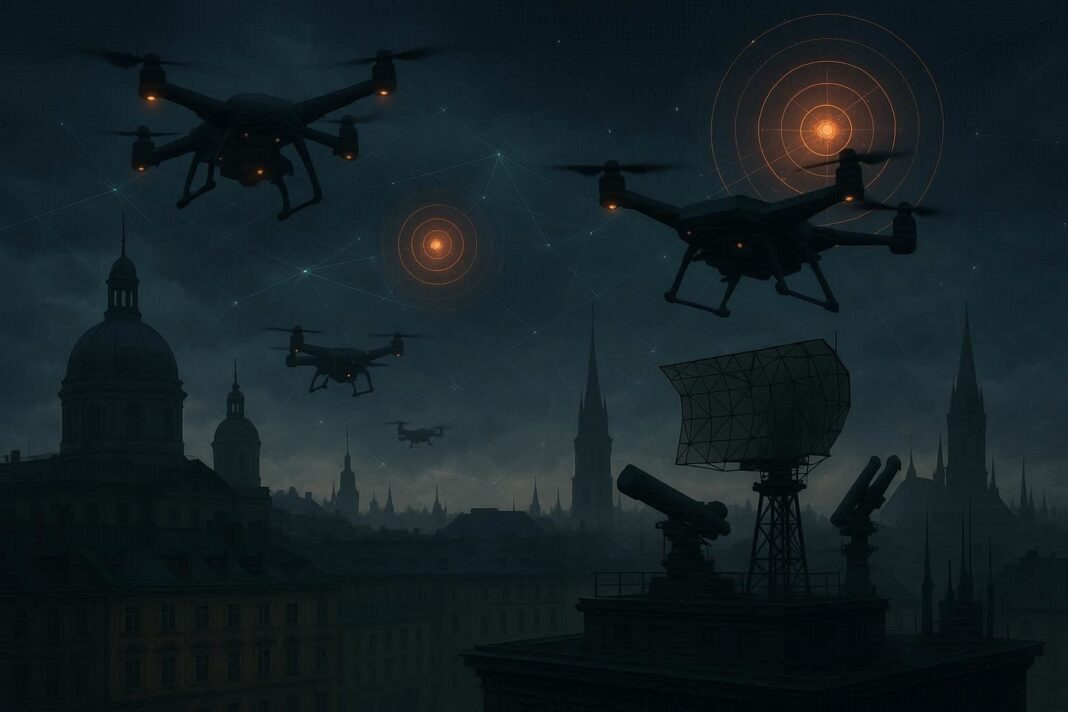For almost eighty years, Europe believed its peace was unshakable. But recent incidents across the continent have left many wondering if that peace is slipping away. The past few months have seen a surge in mysterious drone incursions, cyberattacks, and disruptions to airspace that many officials suspect are linked to hybrid warfare operations from Russia. These activities don’t look like traditional battles. Instead, they belong to what experts now call the “gray zone” — a state where nations are not officially at war, but peace no longer feels secure either.
The Alarming Shift from Peace to Hybrid Warfare
Airports across Europe — from Copenhagen to Munich — have been forced to shut down temporarily after unidentified drones entered restricted airspace. Fighter jets were scrambled in several countries after radar detected intrusions from unidentified aircraft. In one instance, three foreign warplanes violated the airspace of a European alliance member, sparking urgent military responses.
These repeated incidents have shaken public confidence and raised difficult questions about Europe’s preparedness. Many nations, long used to peacetime comfort, are suddenly confronting the reality that they might not be ready for large-scale disruption. In a world where drones can cross borders quietly and cyberattacks can paralyze key systems, traditional ideas of safety are being challenged by the growing reach of hybrid warfare.
UK operates Voyager aircraft to refuel Typhoon jets over Europe amid Russian air activity
Adding to the anxiety is the uncertainty over how committed the United States remains to defending Europe. Once the cornerstone of the NATO alliance, America’s role now feels less predictable. While U.S. leaders express concern, their mixed messages about European defense commitments have left allies uneasy.
A Web of Drones, Shadows, and Sabotage
The growing pattern of incidents suggests a deliberate campaign to test Europe’s defenses — a clear sign of hybrid warfare. These “gray zone” tactics use drones, cyberattacks, and undersea sabotage to spread instability without declaring war.
Security reports link many of these disruptions to a “shadow fleet” of aging tankers and civilian ships used for covert operations near undersea cables and energy routes, raising fears of sabotage. Several European nations that support Ukraine have faced repeated drone incursions and signal jamming, part of a slow, persistent effort to confuse and weaken their defenses.
European chemical producers hit by U.S. tariffs after energy crisis recovery stalls
Across NATO’s eastern flank, military leaders are coordinating air defenses and exploring a “drone wall” to detect intrusions. But countering such low-cost threats with advanced fighter jets is expensive and inefficient. The real danger lies not only in the drones but in the growing sense of confusion and vulnerability that hybrid warfare continues to create across Europe.
A Continent on Edge While America Ignores Hybrid Warfare Signs
While Europe struggles to contain rising drone incursions and cyberattacks, attention across the Atlantic remains elsewhere. Meanwhile, in the United States, domestic political tensions and protests have largely overshadowed Europe’s growing hybrid warfare crisis. As a result, what feels urgent in European capitals barely registers in the American conversation.
NATO officials warn that this lack of awareness could weaken the alliance that has safeguarded Europe for generations. Although member states have pledged to raise defense spending to about 3.5% of GDP, economic struggles and political divisions make it hard to deliver. Consequently, many citizens are weary of austerity and skeptical about greater defense budgets, leaving governments torn between public pressure and growing security threats.
Mystery drones swarm top-secret NATO weapons factories in Belgium, Thales raises alarm
Military drills and joint training among NATO allies are becoming more frequent, especially in Eastern Europe, where nations familiar with Cold War tensions remain on high alert. Airspace violations and cyber intrusions serve as constant reminders that hybrid warfare is already in motion. In other words, Europe is facing a conflict that is not always visible but is nonetheless very real.
Experts stress that this challenge goes beyond the battlefield. Cyberattacks on power grids and financial systems could cause chaos without a single bullet being fired. Therefore, true defense now means resilient digital systems and public readiness. In addition, governments are reviving civil preparedness programs and urging citizens to stay informed and equipped for emergencies.
Across Europe, the unsettling reality is taking hold — the continent may already be fighting a silent conflict, waged through drones, data, and fear. On the other hand, while America looks away, Europe’s sense of peace quietly fades under the shadow of hybrid warfare.

